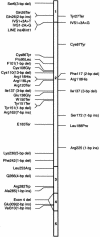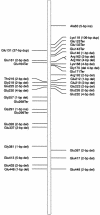A comprehensive mutation analysis of RP2 and RPGR in a North American cohort of families with X-linked retinitis pigmentosa
- PMID: 11992260
- PMCID: PMC379141
- DOI: 10.1086/340848
A comprehensive mutation analysis of RP2 and RPGR in a North American cohort of families with X-linked retinitis pigmentosa
Abstract
X-linked retinitis pigmentosa (XLRP) is a clinically and genetically heterogeneous degenerative disease of the retina. At least five loci have been mapped for XLRP; of these, RP2 and RP3 account for 10%-20% and 70%-90% of genetically identifiable disease, respectively. However, mutations in the respective genes, RP2 and RPGR, were detected in only 10% and 20% of families with XLRP. Mutations in an alternatively spliced RPGR exon, ORF15, have recently been shown to account for 60% of XLRP in a European cohort of 47 families. We have performed, in a North American cohort of 234 families with RP, a comprehensive screen of the RP2 and RPGR (including ORF15) genes and their 5' upstream regions. Of these families, 91 (39%) show definitive X-linked inheritance, an additional 88 (38%) reveal a pattern consistent with X-linked disease, and the remaining 55 (23%) are simplex male patients with RP who had an early onset and/or severe disease. In agreement with the previous studies, we show that mutations in the RP2 gene and in the original 19 RPGR exons are detected in <10% and approximately 20% of XLRP probands, respectively. Our studies have revealed RPGR-ORF15 mutations in an additional 30% of 91 well-documented families with X-linked recessive inheritance and in 22% of the total 234 probands analyzed. We suggest that mutations in an as-yet-uncharacterized RPGR exon(s), intronic changes, or another gene in the region might be responsible for the disease in the remainder of this North American cohort. We also discuss the implications of our studies for genetic diagnosis, genotype-phenotype correlations, and gene-based therapy.
Figures



References
Electronic-Database Information
-
- National Center for Biotechnology Information, http://www4.ncbi.nlm.nih.gov/ (for descriptions of genes and sequences)
-
- Online Mendelian Inheritance in Man (OMIM), http://www.ncbi.nlm.nih.gov/Omim/ (for RP2 [MIM 312600], RP3 [MIM 312610], RP6 [MIM312612], RP24 [MIM 300155], and XLRP [MIM 26800])
-
- RetNet, http://www.sph.uth.tmc.edu/Retnet/ (for map locations of retinal disease loci and genes)
References
-
- Balhausen WG (2000) Genetic testing for familial adenomatous polyposis. Ann NY Acad Sci 910:36–47 - PubMed
-
- Bennett J, Maguire AM (2000) Gene therapy for ocular disease. Mol Ther 1:501–505 - PubMed
-
- Bessant DA, Ali RR, Bhattacharya SS (2001) Molecular genetics and prospects for therapy of the inherited retinal dystrophies. Curr Opin Genet Dev 11:307–316 - PubMed
-
- Bhattacharya SS, Wright AF, Clayton JF, Price WH, Phillips CI, McKeown CM, Jay M, Bird AC, Pearson PL, Southern EM (1984) Close genetic linkage between X-linked retinitis pigmentosa and a restriction fragment length polymorphism identified by recombinant DNA probe L1.28. Nature 309:253–255 - PubMed
Publication types
MeSH terms
Substances
Associated data
- Actions
- Actions
- Actions
- Actions
- Actions
Grants and funding
LinkOut - more resources
Full Text Sources
Other Literature Sources
Medical
Molecular Biology Databases

